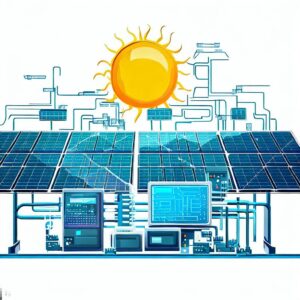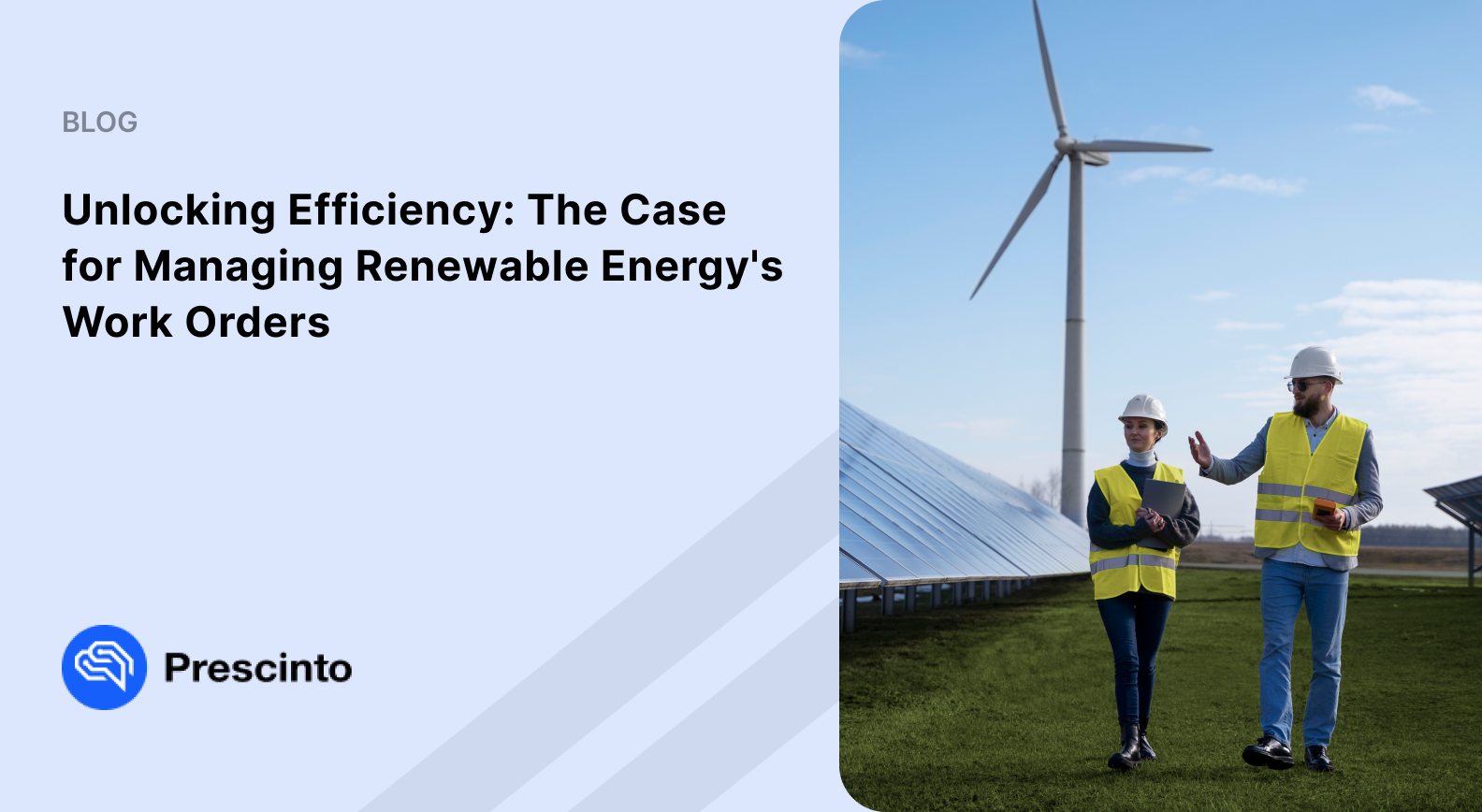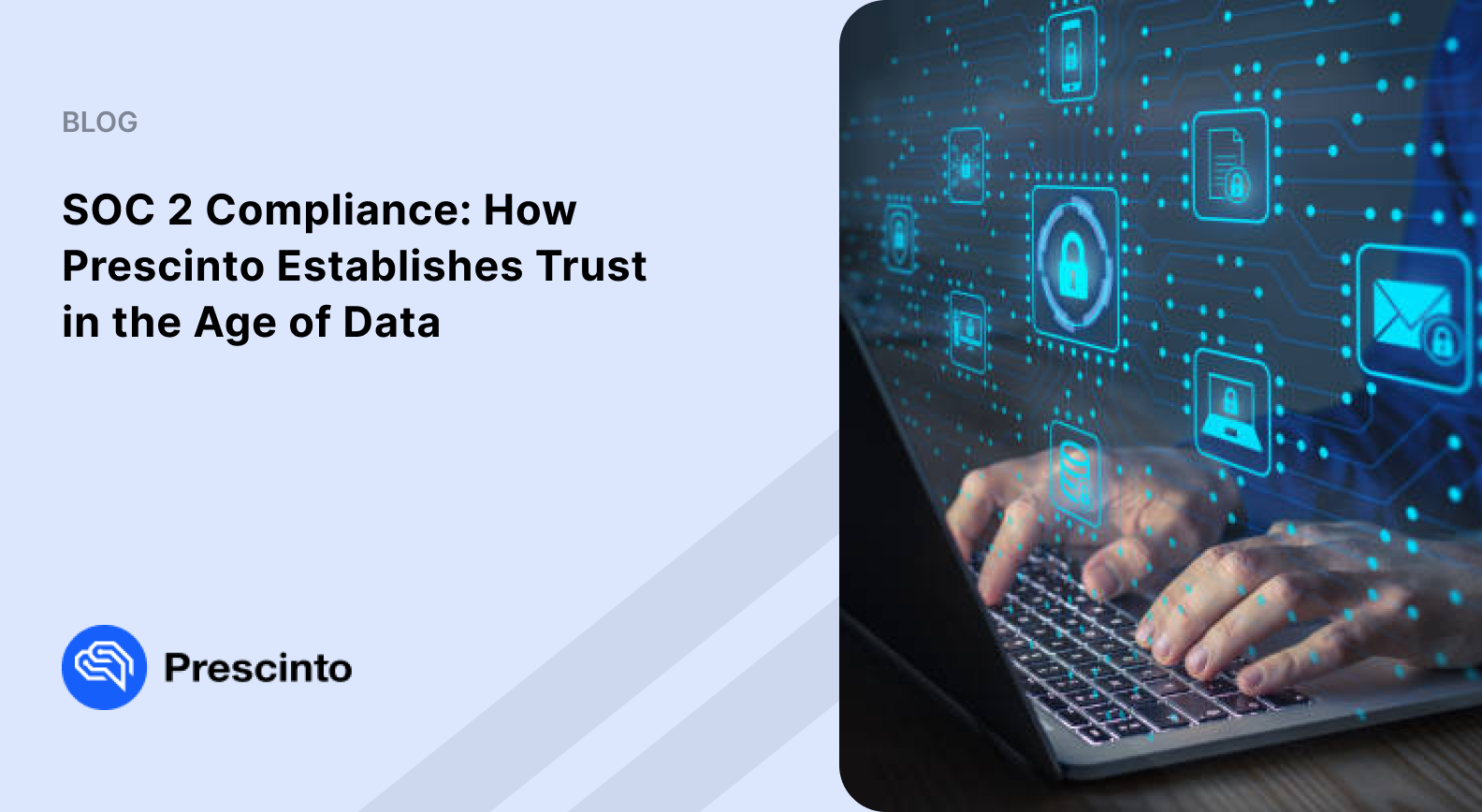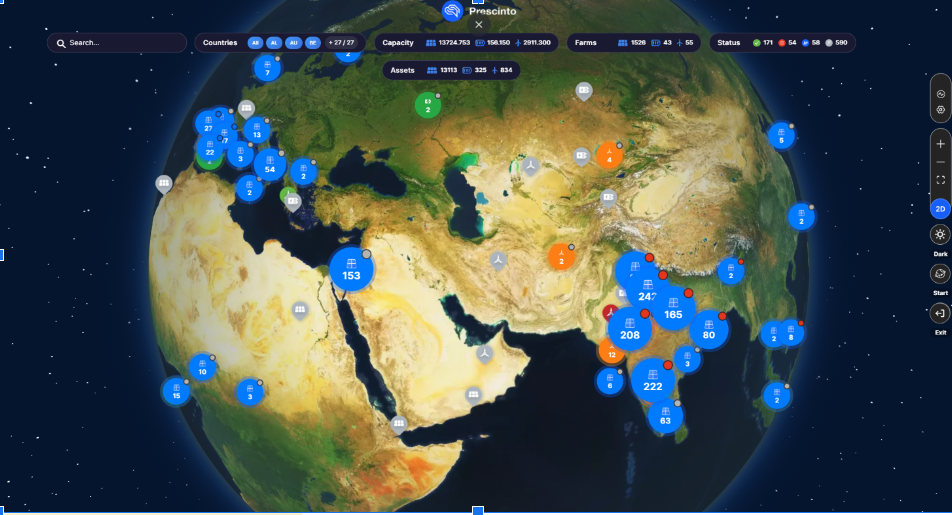The Importance of SCADA Systems in Wind and Solar Power Plants

- August 25, 2023
- Prescinto
What is a SCADA System?
SCADA stands for supervisory control and data acquisition. It is a software that enables real-time monitoring and control of industrial processes. SCADA systems are critical tools for monitoring and managing wind & solar power plants in power management. They gather and analyze data from various sensors and devices, providing operators with up-to-the-minute insights into the power plant’s status.
With this information, operators can make informed decisions and take proactive steps to optimize the plant’s performance, including minimizing downtime and maximizing energy output. Implementing a reliable and proven SCADA control system or SCADA monitoring system is critical to the success of any power system.
How Does a SCADA Control System Work?
A SCADA system works as a centralized control hub for monitoring and managing industrial processes across various locations. A typical SCADA control system comprises three primary components:
- Human-Machine Interface (HMI)
- Remote Terminal Unit (RTU)
- Programmable Logic Controller (PLC)
The HMI provides operators with a user-friendly graphical interface to monitor and control the system. Operators can view real-time data through the HMI, including equipment status, power output, and other critical metrics.
They can also control the system by adjusting parameters and settings, such as the angle of the wind turbine blades or the orientation of the solar panels. The HMI also enables operators to set alarms and notifications to alert them when issues arise, allowing them to take prompt action to address the problem and prevent downtime or other issues.
The RTU device collects sensor data and transmits it to the SCADA system. The PLC is a computer that controls the power plant based on the data received from the RTU.
SCADA for Power Management Systems
Power management systems typically use SCADA for real-time monitoring and control. They provide operators with a wealth of information about the status of the power plant, including power output, weather conditions, and equipment status. This information helps identify and resolve plant issues quickly and boost the power plant’s performance.
Key Features of SCADA for Power Plants
- Real-Time Monitoring: SCADA systems provide real-time monitoring of power plant operations, enable operators to track performance, and identify potential issues as they arise.
- Remote Control: SCADA systems enable remote control of power plant equipment, allowing operators to make adjustments to optimize device performance without needing to be physically present.
- Data Analysis and Reporting: SCADA systems provide robust data analysis and reporting tools, enabling operators to analyze trends, identify inefficiencies, and optimize plant performance over time.
- Alarms and Alerts: SCADA systems can be configured to generate alarms and alert notifications as and when issues arise, enabling operators to respond quickly and minimize downtime.
- Historical Data Storage: SCADA systems store historical data of power plant operations, providing a valuable resource for analyzing past performance and identifying areas for improvement.
- Scalability: SCADA systems are highly scalable, making them suitable for use in all sizes and configurations of power plants.
- Customization: SCADA systems can be customized to meet the specific needs of individual power plants, including integration with other systems and software.
Control and Monitoring for Power Plants
SCADA systems have two main components: control systems and monitoring systems.
SCADA control systems allow operators to make adjustments and control the performance of wind and solar power plants in real-time. By monitoring the performance of individual components, operators can identify areas where performance can be optimized, and take corrective actions as necessary. This can include adjusting the pitch angle of wind turbine blades or adjusting the output of solar panels.
On the other hand, SCADA monitoring systems provide real-time data on the performance of individual components, allowing operators to identify problems and take corrective actions before they become bigger issues. By analyzing data from various sensors, monitoring systems can detect changes in wind speed, solar radiation levels, and other environmental factors that affect the performance of the power plant.
Here are some additional points for each category:
Solar Power Plant:
| Control Systems | Monitoring Systems |
| Solar Panel Control and Monitoring | Irradiance Monitoring |
| Inverter Control | Temperature Monitoring |
| Battery storage Control | Power output Monitoring |
| Load balancing Control | Weather Monitoring |
| Cybersecurity Control | Cybersecurity Monitoring |
| Plant Control and Monitoring | Performance ratio Monitoring |
| Equipment Condition Monitoring | Shade analysis Monitoring |
| Maintenance Management | Alarm Monitoring |
Wind Power Plant:
| Control Systems | Monitoring Systems |
| Wind Turbine Control and Monitoring | Vibration Monitoring |
| Real-time Condition Monitoring | Temperature Monitoring |
| Blade pitch Control | Power output Monitoring |
| Yaw Control | Wind speed Monitoring |
| Generator Control | Oil level Monitoring |
| Power converter Control | Gearbox Monitoring |
| Load balancing Control | Control of SCADA Network |
| Cybersecurity Control | Cybersecurity Monitoring |
SCADA System for Solar Plants
The architecture of a SCADA system for solar plants typically includes remote terminal units (RTUs), supervisory computers, and human-machine interface (HMI) software. The RTUs are responsible for monitoring and controlling the solar panels and inverters, while the supervisory computers gather and analyze data from the RTUs. The HMI software allows operators to interact with the system and monitor the performance of the solar plant.

Img Link: DALL-E
Advantages | How SCADA Makes Solar Power Management Easier
SCADA offers several benefits that make solar power management easier, including:
-
Real-time Monitoring and Control
SCADA systems provide operators with real-time monitoring and control capabilities, enabling them to track the performance of solar panels and inverters and make adjustments in real-time. This functionality allows operators to react quickly to weather conditions, equipment malfunctions, or other factors impacting energy production.
- Improved performance optimization: SCADA systems gather and analyze real-time data from various sensors and devices installed in the solar power plant. Operators can use this data to identify areas for improvement and optimize performance. By adjusting settings, scheduling maintenance, and planning for future upgrades, operators can maximize the efficiency and performance of the solar power plant. Additionally, SCADA systems can predict when maintenance will be needed, helping operators to plan maintenance activities to minimize downtime and ensure smooth plant operation.
- Predictive Maintenance: SCADA can help operators predict when maintenance will be needed by analyzing real-time data from sensors and devices in the plant. The system can detect anomalies and potential issues before they become significant problems, allowing maintenance to be scheduled proactively and preventing costly downtime, and ensuring that the solar power plant continues to operate at peak performance.
- Enhanced Fault Detection and Diagnosis: SCADA systems also provide operators with diagnostic information that helps them identify the root cause of the problem. This information includes detailed data on voltage levels, current levels, and temperature Furthermore, SCADA systems can track the maintenance history of each component of the solar power plant and schedule maintenance activities based on the usage patterns of the equipment. This approach helps prevent unexpected downtime, improves the longevity of the equipment, and reduces maintenance costs.
- Calibration Factor: SCADA systems can help operators calibrate and adjust the output of solar panels and inverters, ensuring they operate at their optimal levels. This capability helps maximize energy production and extend the lifespan of the solar power plant.
- Remote Monitoring: SCADA systems allow operators to monitor and maintain the solar power plant remotely, reducing the need for on-site personnel and minimizing maintenance costs. Additionally, remote monitoring enables operators to identify and address problems quickly, minimizing downtime and maximizing energy production.
- Data Management and Analysis: SCADA systems provide operators with tools for collecting, storing, and analyzing data from the solar power plant. SCADA systems can provide operators with a range of reporting tools, such as dashboards and performance reports, to visualize the data and monitor the performance of the solar power plant. This capability enables operators to make data-driven decisions, optimize performance, and plan for future upgrades and expansions.
Key takeaways:
- Remote Terminal Units (RTUs) monitor and control solar panels and inverters.
- Supervisory Computers gather and analyze data from the RTUs.
- Human-Machine Interface (HMI) software allows operators to interact with the system and monitor performance.
- Real-time Monitoring and Control maximizes clean energy generation.
- Improved performance optimization through data analysis and predictive maintenance.
- Enhanced fault detection and diagnosis.
SCADA System for Wind Farms
The architecture of a SCADA system for Wind Farms is similar to that of a Solar Plant, with RTUs, Supervisory Computers, and HMI software. However, the components may be more advanced and tailored to the specific needs of a wind farm. For instance, wind turbines often have complex control systems that must be integrated with the SCADA system. Additionally, wind farms may require more advanced monitoring capabilities due to the complexity and scale of the operation. As a result, SCADA systems for wind farms may include specialized components such as turbine control interfaces, advanced analytics, weather monitoring, and alarm management.
Advantages | How It Makes Wind Power Management Easier
SCADA Systems offer several advantages that make Wind Power Management easier, including:
- Real-time monitoring and control: Provide operators with real-time monitoring and control capabilities, allowing them to monitor the performance of wind turbines and adjust the configuration as necessary. This helps maximize energy production and ensure efficient wind power plant operation.
- Predictive maintenance: Operators predict when maintenance will be needed based on performance data. This allows them to schedule maintenance optimally, minimizing downtime and ensuring that the wind power plant continues to operate at peak performance.
- Enhanced fault detection and diagnosis: SCADA systems can detect faults in wind turbines by analyzing data from various sensors and provide operators with real-time alerts and diagnostic information. This capability helps operators quickly identify and address problems before they become more prominent. Early detection of faults enables operators to take corrective actions such as scheduling maintenance, ordering replacement parts, or even shutting down the turbine to avoid catastrophic failures. This not only improves the overall performance of the wind power plant but also helps reduce repair costs and prolongs the lifespan of the equipment.
- Detect faults in wind turbines and provide operators with alerts and diagnostic information. This helps operators quickly identify and address problems, minimizing downtime and ensuring the wind power plant operates at peak performance.
- Improved Energy Forecasting: Monitors weather conditions and predict wind patterns, allowing operators to make informed decisions about power generation. This helps optimize energy production and minimize waste.
- Improved safety: SCADA systems monitor wind speeds and other weather conditions in real-time, enabling operators to shut down turbines if conditions become unsafe. This functionality helps to ensure the safety of workers and equipment, minimizing the risk of accidents and damage to the wind farm. By shutting down turbines during high winds or other hazardous conditions, operators can also prevent unnecessary wear and tear on the equipment, ultimately extending the life of the wind turbines and improving the overall performance of the wind farm.
- Turbine Control Interfaces: The control system for each wind turbine must be integrated with the SCADA system, allowing operators to monitor and adjust the turbine’s performance in real-time.
- Advanced Analytics: Wind farms generate vast amounts of data, and advanced analytics can help operators identify patterns, trends, and anomalies that can affect performance. SCADA systems for wind farms may include specialized analytics tools to help operators make informed decisions.
- Weather Monitoring: Wind is a critical resource for wind farms, and weather conditions can have a significant impact on energy output. SCADA systems for wind farms may include specialized weather monitoring capabilities to help operators optimize performance based on current and forecasted weather conditions.
- Alarm Management: Wind farms are complex systems with many different components, and it’s essential to identify and address issues as they arise quickly. SCADA systems for wind farms may include advanced alarm management capabilities, allowing operators to identify and respond to critical issues quickly.
Key takeaways:
- Similar architecture to solar plants, but components may be more advanced and tailored to wind farm needs.
- Real-time monitoring and control optimize power generation.
- Predictive maintenance based on performance data.
- Ability to predict wind patterns allows for informed decisions about power generation.
- Enhanced fault detection and diagnosis.
What are the Challenges Associated with Implementing a SCADA System?
Implementing a SCADA System can be complex and challenging and may require investing significant time & additional resources. Integration with existing systems can be challenging, and technical difficulties may arise during the setup and configuration of the system.
Some of the critical factors that make implementing a SCADA system challenging include the following:
- Complexity: SCADA Systems can be complex to set up and configure, especially for large and complex power plants. The implementation process requires technical expertise, and it can be time-consuming.
- Integration: Integrating SCADA Systems with existing systems and equipment can be challenging. It requires a thorough understanding of the existing systems and communication protocols to ensure seamless integration.
- Cost: The cost of implementing a SCADA System can be high. It involves hardware, software, and installation costs, as well as ongoing maintenance and support costs.
- Cybersecurity: SCADA systems are often connected to the Internet, which makes them vulnerable to cyber-attacks. Implementing appropriate cybersecurity measures to protect the system and ensure the power plant’s security is vital.
- Customization: Another critical factor that can make implementing a SCADA system challenging is customization. Power plants have different needs and requirements, and a one-size-fits-all approach may not be suitable. Therefore, the SCADA system needs to be tailored to the specific needs of the power plant, which requires expertise and may add complexity to the implementation process.
- Interoperability: Interoperability is another critical factor that makes implementing a SCADA system challenging. SCADA systems must work seamlessly with other systems and equipment used in the power plant. Ensuring compatibility and interoperability with other systems can be challenging, especially in cases where the power plant uses equipment from multiple vendors.
How to Choose the Right Software for Your Solar & Wind Plants?
When comparing SCADA features, it’s essential to consider the specific needs and requirements of the power plant. SCADA systems for Solar and Wind Power Plants offer similar characteristics, such as Real-Time Monitoring and Control, Data Acquisition and Analysis, and Predictive Maintenance.
However, some differences regarding scalability, flexibility, and integration capabilities may arise. For instance, a SCADA system designed for a large-scale Wind Power Plant may require more advanced features and greater scalability than a small-scale Power Plant designed for Solar Energy Generation.
Choosing the right SCADA for your Solar and Wind Power Plants is critical to ensuring optimal performance and efficiency. Here are some key factors to consider when making your selection:
- Compatibility: Ensure that the SCADA is compatible with the hardware and equipment used in your solar or wind power plant.
- Scalability: Choose a SCADA that can scale to meet your future needs as your power plant grows.
- Functionality: Look for a SCADA that provides the necessary functionality for your power plant, including monitoring, control, data analysis, and reporting.
- User Interface: Consider the ease of use of the SCADA software and whether it provides a user-friendly interface for operators and maintenance personnel.
- Integration Capabilities: Ensure that the SCADA software can integrate with other systems and software used in your power plant, such as Energy Management Systems, Control Systems, and Data Analytics Platforms.
- Reliability: Search for a dependable and established SCADA system with a history of successful installations and smooth operations in the field.
- Security: Ensure the SCADA provides robust security features to protect against cyber threats and unauthorized access.
- Support and maintenance: Choose a vendor that provides comprehensive support and maintenance services, including training, troubleshooting, and software updates.
Ultimately, the choice will depend on the specific needs and requirements of the power plant, as well as the budget and available technical expertise for implementing and maintaining the system.
Final Thoughts/Conclusion
In conclusion, SCADA is critical in managing wind and solar power plants. They provide operators with real-time monitoring and control and help optimize the power plant’s performance. While implementing a SCADA system can be challenging, the benefits are well worth the effort. Choosing the right software for your solar or wind power plant can ensure you have the tools to manage your power plant effectively and efficiently. With the increasing importance of Renewable Energy sources, SCADA systems will undoubtedly play an even more critical role.
About Author





